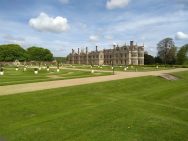
Back from a five day break in an English Heritage cottage in the grounds of the lovely Kirby Hall, and the cottage proved to be perfectly suited to a couple with more than enough space for two little’uns. Having said that, it didn’t stop one of the pair running some heavy duty furniture up to the back door every night and still not sleeping for the first three nights of the break.
On the first day we drove to Lyvedon and Oulton. At Lyvedon, we visited the first of what turned out to be the Tresham Trail. The garden lodge was created in the late 16thC, a fashionable pleasure garden house that was also a place of secret Catholic worship. Never finished, the whole place was brought to life by the excellent audio commentary. Oundle, a small market town is now mostly renowned by Oundle School is a co-educational boarding and day independent school in the ancient market town of Oundle in Northamptonshire.
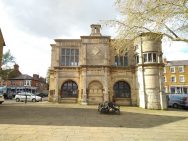
The school has been governed by the Worshipful Company of Grocers of the City of London since its foundation by Sir William Laxton in 1556. Oundle has eight boys’ houses, five girls’ houses, a day house and a junior house. Together these accommodate more than 1100 pupils. It is the third largest boarding school in England after Eton and Millfield. We also got to Rothwell and discovered the first of Tresham’s buildings, the Rothwell Market House, started in the 1570s and, familiarly, never finished. It was completed however (1578) and is still used today, with the first floor housing the Rothwell Town Council
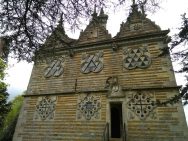
Day two saw us at Rushton Triangular Lodge and delightful building was again designed by Sir Thomas Tresham (father of one of the Gunpowder Plotters) and constructed between 1593 and 1597. It is a testament to Tresham’s Roman Catholicism: the number three, symbolising the Holy Trinity, is apparent everywhere. There are three floors, trefoil windows and three triangular gables on each side.On the entrance front is the inscription ‘Tres Testimonium Dant’ (‘there are three that give witness’), a Biblical quotation from St John’s Gospel referring to the Trinity.
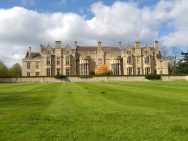
It is also a pun on Tresham’s name; his wife called him ‘Good Tres’ in her letters. Apparently it’s the only design of Trsham’s finished in his lifetime. We also took in a brief visit to Rushton Hall for an alcoholic beverage to take in the building’s lovely architecture and the particularly impressive Great Hall. It was actually built by Sir William Tresham (15thC) and was the original family home in the area.
On Day three, we completed the audio tour of Kirby Hall, although as we were actually stationed in the grounds we had already wandered around the gardens outside of general visiting opening hours. Kirby Hall is one of England’s greatest Elizabethan and 17th-century houses, once owned by Sir Christopher Hatton, Lord Chancellor to Queen Elizabeth I. Although this vast mansion is partly roofless, the walls show the exceptionally rich decoration that proclaims that its successive owners were always at the forefront of new ideas about architecture and design.The Great Hall and state rooms remain intact, refitted and redecorated to authentic 17th- and 18th-century specifications.
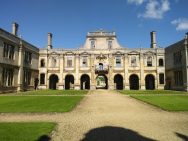
Again the audio tour was a welcome addition and the enclosed (roofed) interiors proved to be both bigger and in some ways more informative than comparable houses that were continuously occupied and therefore subject to change generation to generation. The rest of the day we filled with a return visit to the lovely village of Lyddington (but not the Bede House, which we had visited on a previous visit) and Uppingham, which delighted with one of the best coffees at an independent shop that we only visited by chance, virtually at close of play!
And if that wasn’t enough on the way back home, we managed to fit in the Eleanor Cross at Geddington; In 1290 Eleanor of Castile, died at Harby in Nottinghamshire. The places where her body rested during the journey south to its tomb in Westminster Abbey were marked by stone crosses.The stately triangular Geddington cross, with its canopied statues surmounted by a slender hexagonal pinnacle, is the best-preserved of only three intact survivors.

Finally , we called in to see the Packhorse Bridge at Moulton, a pretty four-arched late medieval bridge, spanning the River Kennett on the old route from Cambridge to Bury St Edmunds.
All in all, a lovely break, blessed with generally dry if coolish weather, although despite protestations that it would be ‘a dream’ to stay somewhere so isolated, it appears that having experienced it (and accompanying gathering of peacocks), this very specific type of location is no longer deemed suitable 🙂
